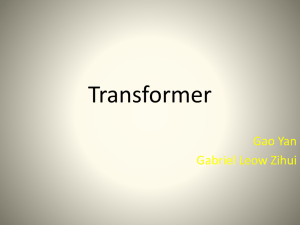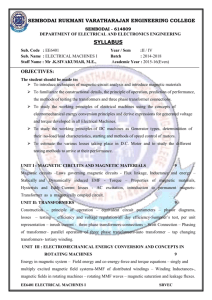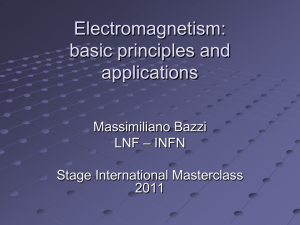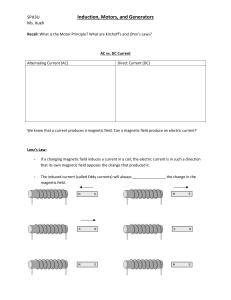SECTION 7: ELECTROMAGNETIC CIRCUITS MAE 2055 – Mechetronics I
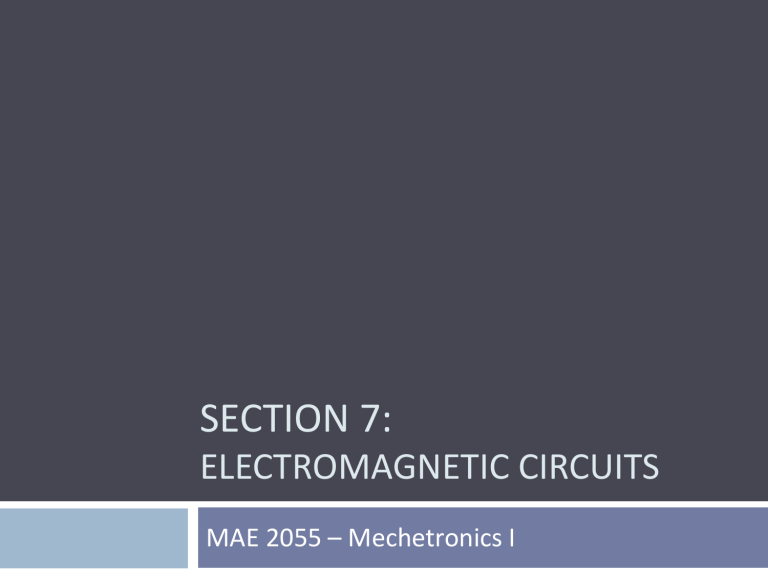
SECTION 7:
ELECTROMAGNETIC CIRCUITS
MAE 2055 – Mechetronics I
2
Electromagnetic Fundamentals
K. Webb MAE 2055 – Mechetronics I
Ampere’s Law
3
Electrical current flowing through a wire generates a magnetic field encircling that wire
Direction of the field is given by the right-hand rule
Thumb point is direction of the
current
Fingers curl in the direction of the magnetic field
1
0 c
B
dl
I
K. Webb MAE 2055 – Mechetronics I
Coils
4
Strong magnetic fields can be generated when current flows through coils of wire
Magnetic fields from adjacent turns of wire sum to produce a large net field
This is the basis for inductors, electromagnets, transformers, motors, etc. www.brakken.no
K. Webb MAE 2055 – Mechetronics I
Faraday’s Law
5
We have seen that current flowing in a wire (coiled or straight) generates a magnetic field
A changing magnetic flux through a loop or coil of wire will produce a voltage across that coil of wire v
d
B dt
The polarity of the voltage is such that if the loop were closed with an external resistor, the resulting current would generate a magnetic field opposing the original change in magnetic flux – Lenz’s Law
K. Webb MAE 2055 – Mechetronics I
Faraday’s Law – Lenz’s Law
6
Magnetic flux in this loop is into the page and is increasing
If loop were closed with an external resistor, the induced voltage would generate a current in the direction shown
Right-hand rule:
Thumb points opposite flux change
Fingers curl in direction current would flow
Faraday’s Law often written without the minus sign – it’s an indication of polarity, but not necessary
K. Webb v
d
B dt
MAE 2055 – Mechetronics I
7
Mutual Inductance
K. Webb MAE 2055 – Mechetronics I
Mutual Inductance
8
When current flows through an inductor, energy is stored in the form of a magnetic field
Magnetic field, B, penetrates the coil and extends external to the coil
Some of the magnetic field may penetrate another coil
If the field is time-varying,
Faraday’s Law says that it will induce a voltage across the second coil
K. Webb MAE 2055 – Mechetronics I
Mutual Inductance
9
Voltage induced across a coil due to time-varying current flowing in another coil is a result of mutual inductance
Like self inductance, mutual inductance, denoted as M , has units of Henries (H)
Dot convention determines polarity of induced voltages: v
1
L
1 di
1
M dt di
2 dt v
2
L
2 di
2 dt
M di
1 dt v
1
L
1 di
1
M dt di
2 dt v
2
L
2 di
2 dt
M di
1 dt
K. Webb MAE 2055 – Mechetronics I
Mutual Inductance – dot convention
10
Dots on mutually coupled inductors are placed such that current entering each dotted terminal produces magnetic flux in the same direction
In both cases below, i
1
and i
2
in the directions indicated produce the magnetic flux, B, in same direction
K. Webb MAE 2055 – Mechetronics I
Mutual Inductance – coupling coefficient
11
Coupling coefficient, k, is a measure of the amount of coupling between two inductors
0 ≤ k ≤ 1
K = 0: completely un-coupled inductors
K = 1: perfect coupling – all magnetic flux generated by one inductor penetrates the coil of the other inductor
Relationship between mutual inductance, M, and the coefficient of coupling, k
M
k L
1
L
2
K. Webb MAE 2055 – Mechetronics I
12
Ideal Transformers
K. Webb MAE 2055 – Mechetronics I
Ideal Transformers
13
Two coils, typically wound around an iron core
Very high magnetic coupling
k → 1
Often used to increase
( step up ) or decrease
( step down ) voltage levels
Time-varying current in the primary coil induces a timevarying magnetic flux that penetrates the secondary coil
Voltage induced across the secondary winding according to Faraday’s Law
K. Webb MAE 2055 – Mechetronics I
Ideal Transformers
14
Assumptions that define an ideal transformer:
Neglect all losses in the windings and in the core
Assume perfect magnetic coupling between the windings
All magnetic flux penetrates both coils k = 1
Infinite self-inductance of both coils
K. Webb
Schematic symbol for an ideal transformer
Turns Ratio
N
2
:N
1
is the ratio of the number of turns on the secondary side, N
2
, to the number of turns on the primary side, N
1
MAE 2055 – Mechetronics I
15
Voltage Ratio
Time-varying voltage applied to the primary winding v
1
V
1 cos
According to Faraday’s Law
1
V
1 cos
N
1 d
dt because equal magnetic flux, Φ, penetrates each of the N1 turns of the primary winding.
Rearranging
d
1
V dt N N
1
1
1 cos
K. Webb
This is an ideal transformer, so all flux completely links both windings, and v t
2
N
2 d
N dt N
1
2 V
1 cos yielding the transformer voltage ratio: v
2 v
1 t t
N
2
N
1
MAE 2055 – Mechetronics I
16
Voltage Ratio
The voltage across each winding is proportional to the number of turns of that winding v v
1
2
N
N
1
2
Rearranging, we see that the voltage seen across the secondary coil is equal to the voltage at the primary multiplied by the turns ratio v
2
v
1
N
2
N
1
K. Webb
This explains the utility of a transformer for stepping voltage from one level to another
Step-up transformer
N
2
N
1
, v
2
v
1
Step-down transformer
N
2
N
1
, v
2
v
1
MAE 2055 – Mechetronics I
17
Current Ratio
The current through each winding is inversely proportional to the number of turns of that winding i
2 i
1
N
1
N
2
Rearranging, we see that the voltage seen across the secondary coil is equal to the voltage at the primary divided by the turns ratio i
2 t
i
1
N
1
N
2
K. Webb
So, if voltage is stepped up, current is stepped down by the same factor, and vice versa
Step-up transformer
N
2
N
1
, i
2
i
1
Step-down transformer
N
2
N
1
, i
2
i
1
MAE 2055 – Mechetronics I
18
Power in an Ideal Transformer
Power delivered to the primary winding is p
1 i
1 v
1
Power delivered to the secondary winding, and to the load, is p
2
2 2 p
2 p
2
i
1
N
1
N
2 i
1
v
1
N
N
1
2 v
1 p
1
All power delivered to the primary winding is transferred to the secondary winding and delivered to the load p
2
p
1
This is the expected result, because we have assumed the transformer is ideal, and therefore lossless.
No power is dissipated in the transformer.
MAE 2055 – Mechetronics I K. Webb
19
Ideal Transformer – a mechanical analogy
A transformer is analogous to a lever
L
1
:L
2
, lever arm ratio is analogous to the transformer turns ratio, N
2
:N
1 d, the displacement of each end of the lever is analogous to the current in each transformer winding
F, the applied force is analogous to
Voltage
K. Webb
For L
1
:L
2
> 1
Output force is greater than the input force,
F
2
> F
1
.
Output displacement is less than the input displacement, d
2
< d
1
.
Work at the input is equal to the work at the output, F
1
∙d transformer.
1
=F
2
∙d
2
. Just as p
1
= p
2 in the
MAE 2055 – Mechetronics I
20
Ideal Transformer – a mechanical analogy
A transformer is analogous to a lever
K. Webb
Lever
F
2
L
L
2
1 F
1 d
F
2
2
L
2 d
2
L
1
d
1
F
1
d
1
Transformer v
2
N
N
1
2 v
1 i
2
N
1 i
1
N
2
2 2 1 1
MAE 2055 – Mechetronics I
21
Impedance Transformation
What is the input impedance seen at the primary side of the transformer when the secondary side drives a load impedance Z
L
?
Z in
V
1
I
1
Load impedance, Z
L
, is related to the voltage and current phasors at the secondary winding as
Z
L
V
2
I
2 and, as we’ve seen
V
1
N
1 V
2
N
2
, I
1
N
N
1
2 I
2
Substituting the expressions for V
1 into the expression for Z in
and I
1
Z in
N
N
2
1
N
N
2
1
V
2
I
2
Impedance seen at the primary is the load impedance divided by the turns ratio squared
Z in
Z
L
N
N
2
1
2
Z
L
K. Webb MAE 2055 – Mechetronics I
22
Ideal Transformer – an example
For the circuit to the right, determine:
• Voltage and current at the primary
• Voltage and current at the secondary
• Power dissipated in the load, P
L
We’ll be calculating these values for a source frequency of ω = 10K rad/sec, so we can redraw the circuit taking that into account
• Represent the source as phasor and express in polar notation
• Calculate the impedance of the 1H inductor at ω = 10K rad/sec
K. Webb MAE 2055 – Mechetronics I
23
Ideal Transformer – an example
Calculate the impedance seen looking into the primary winding, Z’
L
Z
L
Z
L
N
1
N
50
2
2
Z
L j 100
1
100
5 K
j 10 K
Expressing Z’
L
in polar form,
Z
L
111 .
8
63 .
4
Next, calculate the impedance seen by the source, Z s
Z
S
Z
S
50
Z
L
141 .
4
45
100
j 100
We can now calculate the current phasor through the primary winding
I
1
I
1
V
S
Z
S
70 .
7
10
45
0
V
141 .
4
45
mA
K. Webb MAE 2055 – Mechetronics I
24
Ideal Transformer – an example
Next, calculate the voltage phasor at the primary winding
V
1
V
1
I
1
Z
70 .
L
7
45
V
1
7 .
9
18 .
4
V mA
111 .
8
63 .
4
The phasor for the current through the secondary winding is
I
2
I
2
N
N
2
1 I
1
7 .
1
1
10
45
70 .
7
45
mA mA and the voltage phasor at the secondary winding is
V
2
V
2
N
2 V
1
10
N
1
79
18 .
4
1
V
7 .
9
18 .
4
V
K. Webb MAE 2055 – Mechetronics I
25
Ideal Transformer – an example
We can now convert the current and voltage phasors at the primary and secondary sides to instantaneous form if we’d like 𝑣
1 𝑡 = 7.9𝑉𝑐𝑜𝑠 10𝑘 ∙ 𝑡 + 18.4° 𝑖
1 𝑡 = 70.7𝑚𝐴𝑐𝑜𝑠 10𝑘 ∙ 𝑡 − 45° 𝑣
2 𝑡 = 79𝑉𝑐𝑜𝑠 10𝑘 ∙ 𝑡 + 18.4° 𝑖
2 𝑡 = 7.1𝑚𝐴𝑐𝑜𝑠 10𝑘 ∙ 𝑡 − 45°
The final quantity to calculate is the time-average power dissipated in the load, P
L
The magnitude of the phasors represents the peak amplitude, so they are divided by sqrt(2) to give the rms amplitude. The timeaverage power dissipated in the load is
P
L
7 .
1 mA
5 k
2
126 mW
P
L
2
I
L rms
R
L
K. Webb MAE 2055 – Mechetronics I
26
Motors & Generators
K. Webb MAE 2055 – Mechetronics I
Lorentz Force
27
Electrical charge moving through a magnetic field experiences a force
A wire carrying current (moving charge) through a magnetic field will experience a force
Force on the wire can be determined by the right hand rule:
F
L
I
B
F : force vector
I : current vector in the wire
L: length of the wire
B : magnetic field vector
Basis for converting from electrical energy to mechanical energy
K. Webb
Electric motors
Rail guns
MAE 2055 – Mechetronics I
28
Electric Motor Basics – DC motor
Brushes contact the commutator providing current to the armature , causing it to rotate through the magnetic field
Split-ring commutator reverses current flow every half rotation, reversing the force on that half of the armature, completing the rotation
Split ring creates AC current from DC
Real motors have many more poles
MAE 2055 – Mechetronics I K. Webb
Types of Motors – DC motor
29
DC motors
Permanent magnet stator
Wound rotor
Brushes, split-ring commutator
Advantages:
Cheap
Easy to control the speed
Disadvantages:
Brushes wear out
Brushes spark when making/breaking contact generating electrical noise - RFI/EMI
Examples:
Toys
Electric toothbrush
Windshield wipers
K. Webb MAE 2055 – Mechetronics I
Types of Motors – universal motor
30
Universal motors
Wound stator and rotor - in series
Can run on DC or AC
Brushes, split-ring commutator
Always turn in the same direction due to wound stator
Advantages:
Cheap
Easy to control the speed
Good power-to-weight/size
Disadvantages:
Brushes
Loud
Examples:
Circular saw
Blender www.dewalt.com
K. Webb MAE 2055 – Mechetronics I
Types of Motors – Induction motor
31
Induction motors
Wound stator - runs on AC
“Squirrel cage” rotor
Brushless
Rotating field of stator induces current in rotor
Advantages:
Quiet
Reliable - no brushes
Disadvantages:
Speed control is more complicated
Lower power to size/weight
Examples:
Table saw
Washer/dryer
Industrial motors
Window fan
Mtodorov69
MAE 2055 – Mechetronics I K. Webb
Types of Motors – stepper motor
32
Stepper motors
Gear shaped rotor
Stator consists of multiple toothed poles
Rotor teeth align with teeth on energized pole, not others
Poles energized sequentially to step motor through rotation
Advantages:
Precise position control
Disadvantages:
Vibration
Examples:
Printers
Disk drives
K. Webb
Eric Pierce
(View in slide show mode to see animation.)
MAE 2055 – Mechetronics I
Electromagnetic Induction - generators
33
A changing magnetic flux through a loop of wire generates a voltage across the loop
Magnetic flux can change due to movement of the wire loop through B field
This provides a means of converting from mechanical energy (motion) to electrical energy - electrical generators
Motion may be provided by steam, wind, water …
Right hand rule gives the direction of the current
K. Webb www.commons.bcit.ca
Faraday’s Law: v
d
dt
B
MAE 2055 – Mechetronics I
Speakers and Microphones
34
Speakers are linear motors
Audio signal drives a coil in a magnetic field
Cone moves with the coil, moving air to create sound
Microphones are linear generators
Sound waves move a diaphragm, moving a coil through a magnetic field
Audio voltage is induced across the coil
Loudspeaker Cross-section
K. Webb cone
+ coil
N
+
+
+
+ S
-
-
-
-
N
- magnet
MAE 2055 – Mechetronics I

